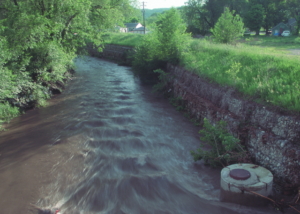The Avoided Cost of Stormwater Remediation
 Here’s something to think about during the next rainstorm: where does all that rainwater go? For most of us, it’s not something to which we give more than a passing thought. But if you’re concerned about saving money and protecting water quality, it’s worth a closer look.
Here’s something to think about during the next rainstorm: where does all that rainwater go? For most of us, it’s not something to which we give more than a passing thought. But if you’re concerned about saving money and protecting water quality, it’s worth a closer look.
In many older New England towns, the infrastructure that conducts sewage from our homes to our wastewater treatment plant is old, crumbling, and not up to today’s needs. During relatively dry times, the system works pretty well. Pipes convey sewage to the sewage treatment plant where it is treated and then released. But during times of intense rainfalls, that excess water running down our streets to our storm drains can overwhelm those older pipes. During those times, the pipes essentially overflow, and raw sewage mixed with stormwater can make it into rivers and oceans. These discharges are called combined sewer overflows, and despite heroic efforts to separate them, they do still exist (see our prior blog posts Money Down the Drain Part 1 and Part 2). Recently in Portland, Maine a heavy rainfall, combined with human error, contributed to a million-plus gallon spill of partially treated sewage directly into Casco Bay.
There are several different strategies for a city or municipality attempting to address its stormwater issues. Coming up with those strategies may be a job for an engineer. Prioritizing those strategies, on the other hand, may be a job for an economist: someone who can weigh the costs and the benefits of each, keeping in mind that there may be hidden costs and benefits to each alternative that are not immediately obvious. Determining the financial costs of each strategy is relatively easy. But coming up with the benefit – the return on investment, or bang for your buck – isn’t as straightforward.
Stormwater management can bring economic and fiscal benefits in terms of “avoided costs.” By reducing the flow of stormwater that needs to be treated, the municipality saves the money that it would otherwise have needed to treat it. That’s not insubstantial. Treating a gallon of stormwater can cost substantial amounts of money in operations and maintenance costs (think electricity, chemicals, filter replacement, sludge disposal, etc.). Every gallon of runoff that is diverted from the treatment plant is that much money saved.
In addition to avoided treatment costs, there are avoided property damage costs. Floods that are caused or exacerbated by excess stormwater (sometimes called “urban flooding”) can cause damage to property. A 2014 study in Cook County, IL, found that chronic and systematic urban flooding had led to property damage claims of over $773 million over a five year period. This number is likely a significant underestimate, as flood insurance only covered a small portion of all damage costs. Less easily measured are the costs of disruption to emergency services like police, fire and ambulance services, and losses to private companies that not only may lose inventory but business as well.
The benefits of dealing with stormwater include the avoided costs of treatment, as well as the avoided costs of flood damage, but that’s not all. Other categories of avoided costs include the costs of treating waterborne diseases. Untreated wastewater that flows into our rivers, streams, and oceans can carry with it diseases and pathogens. Treating those diseases in humans has economic costs. A recent study published in the journal Environmental Health estimated that the “economic burden” – defined as both direct treatment costs and indirect opportunity cost, such as lost productivity – of recreational waterborne illness cost the nation upwards of $2.2 – $3.7 billion annually. That’s a lot of money.
Moreover, contaminated wastewater that flows into our waters can have a detrimental effect on industries that depend on clean water. For example, a recent study from the University of Maine estimated that the closures of shellfish beds caused by toxic algal blooms linked to pollution from combined sewer overflows led to at least $3.6 million in lost revenue over a nine year period. That amounted to approximately 27.4% of revenue from those beds.
Estimating the avoided costs associated with a particular stormwater management option depends on how much stormwater is treated or diverted relative to the baseline, as well as the location attributes of the site and the impacts untreated stormwater can have on the environment it is released into. It isn’t always easy to calculate, but it is information that is needed in order to know the true benefits of a stormwater treatment system.
Stay tuned for upcoming blog posts on the benefit of green infrastructure in stormwater treatment and the fiscal impacts of urban flooding.